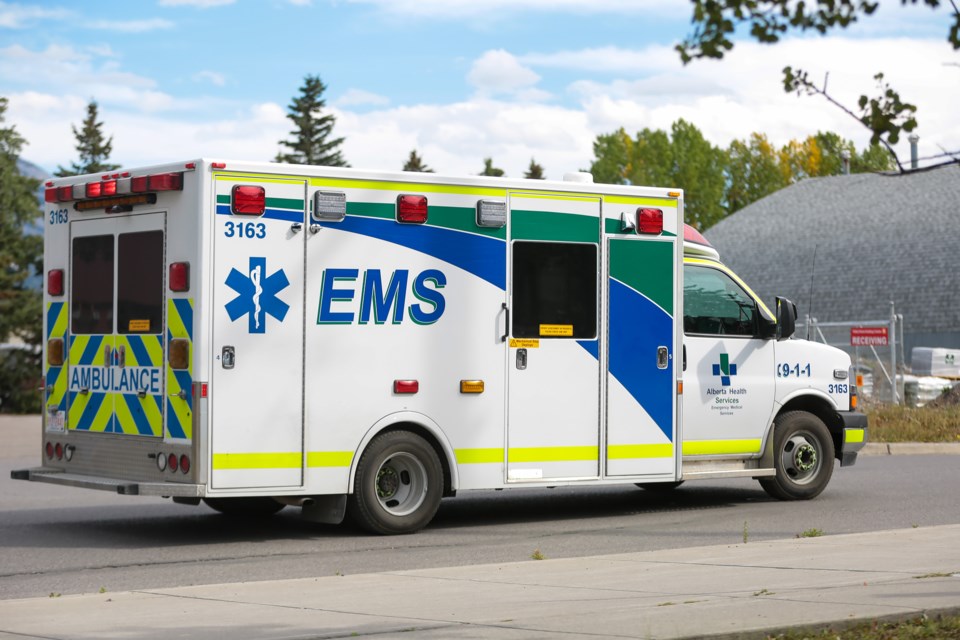CANMORE – Canmore is one of 14 communities to get funding under the province’s new hours-of-work project for EMS.
On March 10, the province announced $14 million in funding to support Alberta Health Services’ Emergency Medical Services (EMS) hours-of-work project, which involves adjusting working hours, shifts and scheduling to lessen fatigue among paramedics.
The program funding applies to 14 communities, including Canmore, Fort Macleod, Lamont, Slave Lake, Wainwright, Castor, Boyle, Vermilion, Drayton Valley, Valleyview, Drumheller, Bassano, Two Hills and St. Paul.
Canmore Mayor Sean Krausert said the municipality appreciates this important step to adjust hours of work for local paramedics, but remains troubled by the limited number of essential resources available to keep residents and visitors safe.
“Beyond this 10-point plan committed to by AHS, it is imperative that Canmore has more ambulances available given the trend to handling more out-of-town calls, and subsequently the increased number of times that we are without an ambulance,” he said.
“It is only a matter of time until lives are lost due to the inadequate resources being provided through EMS. We must not let it get to that point.”
Members of the Bow Valley EMS Crisis Citizen Action Group hope the hours-of-work initiative gets implemented soon.
“We are consistently seeing our core/flex truck out of service from fatigue or not staffed,” according to a Facebook post by the group last week.
The $14 million in funding is part of a $64 million increase, or a 12.2 per cent jump, in the overall $587 million EMS operating budget to help EMS respond to high demand and stress on staff.
The $64 million also includes $28 million to add more ground ambulances and crews in the province, in addition to sustainable funding for helicopter air ambulance services, and $22 million to increase capacity, extend ground ambulance contracts and support integrated operations centres and inter-facility transports projects.
Officials say Alberta Health Services is making progress implementing a 10-point plan to add EMS capacity and ensure the most critical patients receive immediate care. That includes adding ambulances and staff, and launching initiatives to keep suburban ambulances in their home communities more often.
Alberta Health Minister Jason Copping said EMS has been experiencing historic call volume and staffing pressures.
“We’re taking action by significantly increasing EMS funding to improve capacity and access,” he said in a March 10 news release.
“We’re committed to making sure EMS has the resources they need, and I thank all paramedics and EMS support staff for stepping up throughout the pandemic and continuing to be there when we need them.”
The Alberta government also issued a request for proposal on March 10 for a third party to conduct an objective review of the EMS dispatch system.
In addition, the government has also formed the Alberta EMS provincial advisory committee to make recommendations that will help ease pressures on the EMS system.
Province-wide, EMS paramedics and other healthcare professionals are advocating for ambulances designated to serve the communities in which they are stationed to remain there instead of being called away to other locations such as Calgary, potentially for the entire day.
Alberta Health Services’ current province-wide dispatch system for EMS requires the closest ambulance to go on every call, regardless of the priority status of the patient.
For example, ambulances from Canmore are dispatched to Calgary from both the station they are attached to as well as after clearing a city hospital. Local ambulances are also flexed, which means they are moving from station to station to adjust coverage.
In addition, paramedics from Canmore and Banff are required to stay with a patient at city hospitals until a bed is available to treat the patient – commonly referred to as hallway waits – which can often take up hours of time.
The Bow Valley EMS Crisis Citizen Action Group argues efficient patient transfers could alleviate emptying out local communities of emergency ambulances.
“So can staffing the ambulances,” the group posted last week.
On March 8, both Canmore and Banff were on red alert, with no ambulances available to respond.
Then on March 12, Canmore Fire Fighters Association posted its advanced life support fire crew on duty that night was responding to an event because there were no ambulances in town.
In response to this post, Canmore town councillor Wade Graham thanked all the first responders.
“We continue to lobby for a better system on behalf of the citizens of Canmore,” he wrote on Facebook.
“This situation is unsafe and puts lives at risk.”




